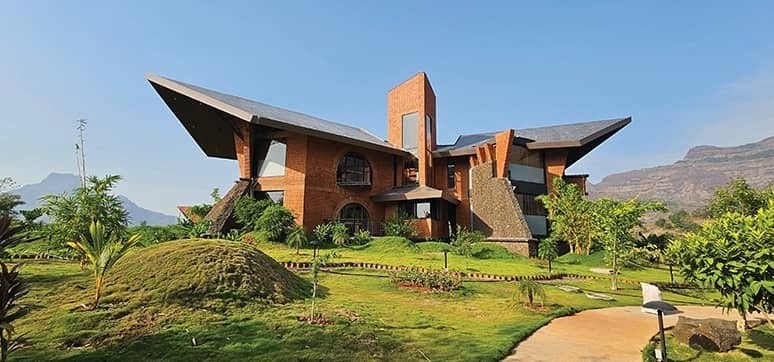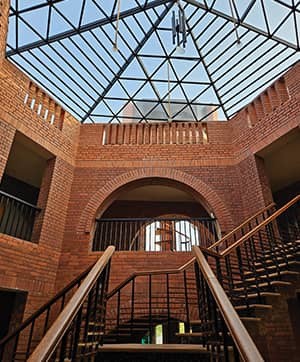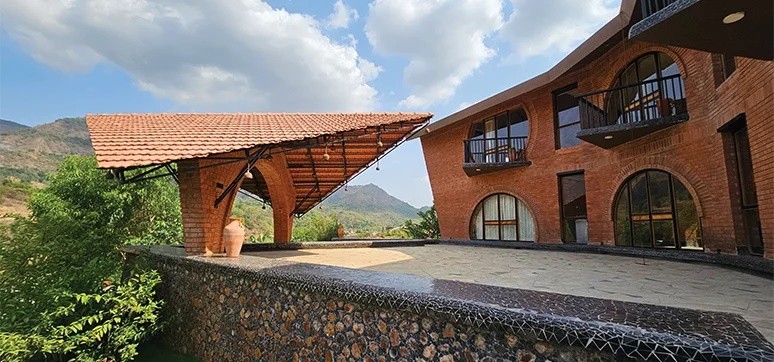Mountain Dust: Where Nature’s Embrace Meets Triskelion Geometry in a Serenade of Organic Architecture

In the heart of Maharashtra, India, where the Matheran Hills stand proud, a breathtaking countryside farmhouse named Mountain Dust emerges as an exemplar of organic architecture. This rural haven, designed to serve as a country home for Mr. Alreja and his family, unfolds across a sprawling 20-acre site at the foothill of Matheran. From the triangular atrium at its core to the Triskelion geometry that harmonizes with nature, Mountain Dust stands as a testament to the philosophy of objective organic architecture, embodying tranquility, simplicity, and a profound connection to the environment.
From Atrium to Wilderness
Mountain Dust is more than just a dwelling; it's a carefully choreographed symphony of spaces. At its core lies a light-filled triangular atrium, serving as the heartbeat of the house. This central space radiates tranquility and connects seamlessly with the surrounding rooms that extend outward, forming a sacred Triskelion geometry. Three directions lead to nature, ensuring that every corner of the house merges with the lush landscapes.
The farmhouse comprises six bedrooms, a pantry, and living spaces intelligently distributed across two floors. Each bedroom is adorned with two triangular balconies, offering panoramic views and a connection to the outdoors. The design seamlessly integrates with the landscape, offering a glimpse into the changing backdrop of the Matheran mountains.

Material Palette: Red, Beige, and Black Harmony
To achieve simplicity and a bucolic ambiance, the architects embraced a minimal natural material palette. The foundation is rooted in black basalt stone, complemented by earth-red bricks for the walls and a distinctive black china mosaic roof. Kota stone flooring with a black china mosaic border along the wall, yellow Jaisalmer stone for the central staircase, beige Shahabad stone for the deck, and black river sand finish granite stone for the toilets form a harmonious color scheme that resonates with the surroundings.
Landscape Integration
More than just a dwelling, Mountain Dust is a commitment to ecological harmony. Over 2000 trees were planted during the construction, enhancing the green cover and maintaining the natural feel of the landscape. Indigenous plants, known for their low maintenance and medicinal properties, were chosen, adding to the organic essence of the retreat.
Nature as the Blueprint
The design concept of Mountain Dust revolves around a sacred knot - the Triskelion geometry. This intricate geometrical system not only provides a maximum 360-degree view of the surrounding mountains but also ensures a unique connection with nature. Various earth mounts strategically control the scale of the house, mimicking miniature mountains that echo the grandeur of Matheran hills. Circular driveways and pathways divide the landscape into zones, further enhancing the connection with the surroundings.

Philosophy of Objective Organic Architecture
Mountain Dust is a living embodiment of the philosophy of objective organic architecture. More than just a structure, it's a form of objective art that responds to the context, topography, climate, materials, and intentions of its inhabitants. Nature becomes the prime attribute, guiding the design in a holistic approach.
The Triskelion geometrical system, the careful choice of materials, and the resonance between man and space contribute to the creation of a centered, healthy, and whole environment. Objective organic architecture, as seen in Mountain Dust, acts as a code language that induces specific feelings, fostering a state of resonance between the observer and the observed.
The creation of Mountain Dust was a journey without traditional blueprints. After conceptual drawings and models, the architects bypassed working drawings, allowing the house to evolve naturally. On-site collaboration between the architect, local masons, and fabricators formed the backbone of this project, eliminating the need for structural and civil engineers. The result is not just a dwelling; it's a testament to the power of organic architecture to shape spaces that resonate with the environment and the soul.
In conclusion, Mountain Dust stands as an illustrious testament to the philosophy of objective organic architecture, inviting individuals to experience a harmonious retreat where the boundaries between architecture and nature blur into a seamless symphony. This countryside farmhouse not only provides a sanctuary for its inhabitants but also serves as a beacon for those seeking a deeper connection with the environment. Mountain Dust is more than a dwelling; it's a living, breathing ode to the beauty of organic architecture.
Related Article : 7 Exceptional Homes Built Into the Desert Blending Luxury With Nature














